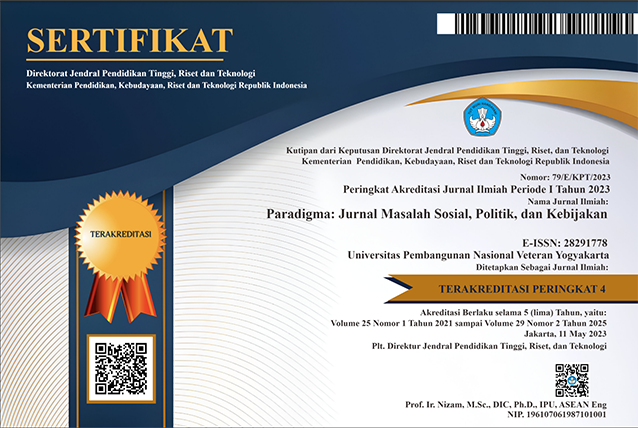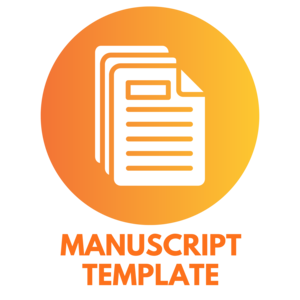Author Guidelines
All manuscripts must be submitted to Paradigma: Jurnal Masalah Sosial, Politik, dan Kebijakan to Editorial Office through Online Submission by assessing the following address: https://jurnal.upnyk.ac.id/index.php/paradigma/submission, where author must register as Author. If authors are experiencing problems on the online submission, they can contact Editorial Office at email paradigma@upnyk.ac.id or chat message by Whatsapp at +62 325-127-918
The following documents must be submitted together with the manuscript (as supplementary files or send to paradigma@upnyk.ac.id):
- A Manuscript with camera ready format under following template (template.doc) or free format submission. However, for free format submission, the minimum requirements of citation and references format must be fulfilled.
- A cover letter, outlines the basic findings of the paper and their significance.
- List of Potential Reviewers for your manuscript. Please send the detail by their email and affiliation address.
Please also provide ScopusID, Publon ID or ORCID of authors when you submit the manuscrpt via online submission system.
English editing
To facilitate proper peer-reviewing of your manuscript, it is essential that it is submitted in grammatically correct English. If you are not a native English speaker, we recommend that you have your manuscript professionally edited before submission or read by a native English-speaking colleague. Professional editing will enable reviewers and future readers to more easily read and assess the content of submitted manuscripts.
The submission with poor English quality will be directly rejected.
Using AI for Publication
The use of Artificial Intelligence (AI) tools (e.g., ChatGPT, Grammarly, etc.) in manuscript preparation is permitted under specific conditions:
- Transparency:
Authors must clearly declare any significant use of AI tools in the writing, translating, or editing of their manuscript in the Acknowledgements section. For example:
“Portions of this manuscript were assisted using ChatGPT (OpenAI, 2025) to enhance grammar and clarity.”
- Accountability:
Authors are fully responsible for the accuracy, originality, and integrity of all content, including any part generated or edited using AI tools. AI must not be listed as an author or co-author. - Limitations:
AI tools must not be used for: - Generating primary research content (e.g., data, figures, or results),
- Creating false or misleading content,
- Rewriting or summarizing previously published material without proper citation.
- Plagiarism and Ethical Compliance:
Authors are required to perform plagiarism checks on their manuscripts, regardless of AI use. All manuscripts must meet the similarity threshold of less than 25% and comply with academic integrity standards. - Peer Review Integrity:
The use of AI tools to assist in peer reviewing tasks is strictly prohibited to maintain the confidentiality and human judgment required in the review process.
Reviewing manuscripts
Every submitted paper is independently reviewed by at least two peer-reviewers. Decision for publication, amendment, or rejection is based upon their reports/recommendation. If two or more reviewers consider a manuscript unsuitable for publication in this journal, a statement explaining the basis for the decision will be sent to the authors within three months of the submission date.
All manuscripts will be checked for plagiarism detection, and therefore we strongly encourage authors to do themselve similarity test before submission. The manusrcipt has higher 25% similarity will be directly rejected.
Revision of manuscripts
Manuscripts sent back to the authors for revision should be returned to the editor without delay. Revised manuscripts can be sent to editorial office through the Online Submission Interface. The revised manuscripts returned later than three months will be considered as new submissions.
STANDARD PAPERS. Original articles 4000-6000 words inclusive of all parts of the paper . Typescripts should be arranged as follows, with each section starting on a separate page.
Title Page
- A concise and informative title.
- A list of author names, affiliation(s), and e-mail addresses.
- The name, complete mailing address (including e-mail address, telephone and fax numbers) of the corresponding author.
Abstract. A concise and factual abstract (150-250 words) is required. The abstract should state briefly the purpose of the research, the principal results and major conclusions. An abstract is often presented separately from the article, so it must be able to stand alone. For this reason, References should be avoided. Also, non-standard or uncommon abbreviations should be avoided, but if essential they must be defined at their first mention in the abstract itself.
Keywords. A list in alphabetical order not exceeding ten words or short phrases, excluding words used in the title and chosen carefully to reflect the precise content of the paper.
Introduction. State the reason for the work, the context, background, aims and the hypotheses being tested. End the Introduction with a brief statement of what has been achieved.
Materials and methods. Include sufficient details for the work to be repeated. Where specific equipment and materials are named, the manufacturer’s details (name, city and country) should be given so that readers can trace specifications by contacting the manufacturer. Where commercially available software has been used, details of the supplier should be given in brackets or the reference given in full in the reference list.
Results and Discussion. State the results of experimental or modelling work, drawing attention to important details in tables and figures and discuss them intensively by citing other references.
Conclusion. Give the main findings and conclude the result and discussion
Acknowledgements. Be brief. If authors refer to themselves as recipients of assistance or funding, they should do so by their initials separated by points (e.g. J.B.T.). Do not acknowledge Editors by name.
References (see Manuscript Specifications below).
Tables. Each table should be inserted in body-text and numbered as well as accompanied by a legend at the top. These should be referred to in the text as Table 1, etc. Avoid duplication between figures and tables.
Figures . Figures and their legends should be inserted in body text manuscript. Figures should be referred to in the text as Fig. 1, Figs 1 & 2, etc. Photographic material should also be referred to as Figures. The figures must be in high resolution and no blur.
CITATIONS AND REFERENCES.
Authors must format their references according to APA 7th edition guidelines. All references cited in the text must appear in the reference list, and vice versa. Please include DOIs or URLs where available.
Use the following formatting examples:
Journal:
Nur, M. M. A., & Buma, A. G. (2019). Opportunities and challenges of microalgal cultivation on wastewater, with special focus on palm oil mill effluent and the production of high value compounds. Waste and Biomass Valorization, 10, 2079-2097.
Books:
Begon, M., Harper, J.L. & Townsend, C.R. (1996) Ecology: Individuals, Populations and Communities, 3rd edn. Blackwell Science, Oxford.
Thesis/Disertation
Tuyttens, F.A.M. (1999) The consequences of social perturbation caused by badger removal for the control of bovine tuberculosis in cattle: a study of behaviour, population dynamics and epidemiology. PhD thesis, University of Oxford.
References should be cited as 'in press' only if the paper has been accepted for publication. Work not yet submitted for publication or under review should be cited as 'unpublished data', with the author's initials and surname given; such work should not be included in the Reference section.



